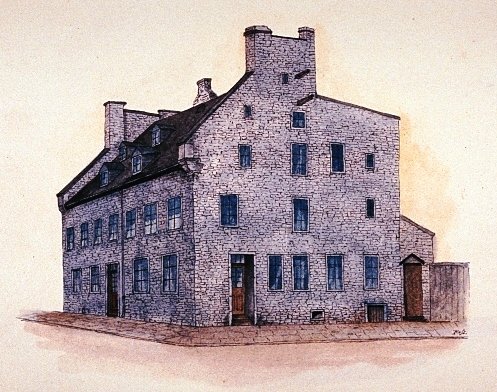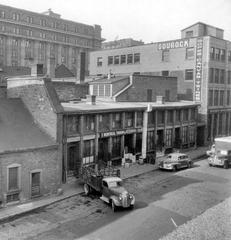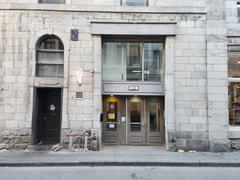
Rue Saint-Pierre Montreal: Complete Visiting Hours, Tickets, and Historical Sites Guide
Date: 15/06/2025
Introduction
Nestled in the heart of Old Montreal (Vieux-Montréal), Rue Saint-Pierre is a living testament to the city’s layered history and vibrant urban culture. As one of Montreal’s oldest and most significant streets, its origins date back to the French colonial era and the founding of Ville-Marie in the 17th century. Over the centuries, Rue Saint-Pierre has evolved from a bustling commercial artery to a hub of creative innovation, blending preserved architectural grandeur with contemporary art, fine dining, and boutique hospitality. Today, it offers visitors a unique opportunity to experience Montreal’s past and present in a single stroll (Old Montreal - Wikipedia).
This guide provides a comprehensive overview of Rue Saint-Pierre—its historical importance, architectural highlights, cultural landmarks, visiting hours, ticket information for nearby attractions, and practical travel tips. Whether you are a history enthusiast, a culture seeker, or simply planning a day out in Old Montreal, you’ll find all the information you need to make your visit memorable (Timeout Montreal, Maple Voyage Diary).
Table of Contents
- Introduction
- Historical Overview
- Key Landmarks & Nearby Attractions
- Visiting Hours, Tickets, and Accessibility
- Cultural Significance and Events
- Practical Visitor Information
- Seasonal Highlights
- Photography Tips
- Frequently Asked Questions (FAQs)
- Conclusion
- References
Historical Overview
Colonial Foundations
Rue Saint-Pierre’s story begins with the creation of Ville-Marie (now Montreal) in 1642 by Paul de Chomedey, Sieur de Maisonneuve, and Jeanne Mance (Old Montreal - Wikipedia). By the late 1600s, the street became a vital artery for commerce, with fur traders, merchants, and artisans building warehouses and homes near its banks. Its proximity to the St. Lawrence River and the Old Port made it an ideal hub for trade and exchange.
19th-Century Financial District
The 19th century saw Rue Saint-Pierre emerge as the heart of Montreal’s financial district. The demolition of Montreal’s fortifications in 1804 ushered in a period of commercial prosperity. English and Scottish merchants established imposing bank headquarters and trading houses, many of which still stand as architectural landmarks (Old Montreal - Wikipedia). The street intersected with St. James Street (now Rue Saint-Jacques), Montreal’s “Wall Street,” home to institutions like the Bank of Montreal and the Royal Bank of Canada.
Architectural Heritage
Rue Saint-Pierre’s built environment showcases a rich timeline of architectural evolution:
- French Colonial and Neoclassical: Early stonework, symmetrical facades, pilasters, and pediments.
- Second Empire: Mansard roofs and ornate dormers reflect 19th-century prosperity.
- Beaux-Arts: Grand entrances, sculpted stonework, and decorative ironwork, especially on institutional buildings (Old Montreal Walking Tour - GPSmyCity, Maple Voyage Diary).
Preservation efforts since the 1960s have ensured these treasures remain, with many buildings now housing galleries, hotels, and restaurants (Timeout Montreal).
Key Landmarks & Nearby Attractions
Notable Buildings
- Former Bank Headquarters: The original Bank of Montreal and Molson Bank buildings symbolize the city’s financial legacy, now often repurposed as event venues or hotels (Maple Voyage Diary).
- Heritage Warehouses: 18th-century stone warehouses, once filled with fur and grain, now serve as creative studios and lofts (thisremotecorner.com).
- Architectural Icons: The New York Life Building (Canada’s oldest skyscraper) and the Royal Bank Building showcase Victorian and Beaux-Arts styles (Old Montreal Walking Tour - GPSmyCity).
Museums and Cultural Institutions
- Pointe-à-Callière Museum: Montreal’s preeminent archaeology and history museum, situated where the city was founded. Open Tuesday–Sunday, 10:00 AM–5:00 PM. Tickets: CAD 20, discounts for students and seniors (Pointe-à-Callière Museum Official Website).
- Centre d’Histoire de Montréal: Housed in a former fire station, it offers engaging exhibits on the city’s urban and social history.
- Centre PHI: A multidisciplinary arts center at 407 Rue Saint-Pierre, known for innovative digital and visual art programming. Typical visiting hours: weekends 12:00–19:30. Admission: CAD 10 (PHI Centre - Habitat Sonore Exhibition).
Religious and Spiritual Sites
- Notre-Dame Basilica: Montreal’s iconic Gothic Revival church, famed for its ornate interior. Open daily, 9:00 AM–5:00 PM. Admission: CAD 10 (Notre-Dame Basilica Official Website).
- Chapelle Notre-Dame-de-Bon-Secours: The “Sailors’ Church.” Features a museum and pilgrimage site (Roaming Historian).
Squares and Streetscapes
- Place d’Youville: A lively square at the intersection of Rue Saint-Pierre, surrounded by heritage buildings and a popular starting point for walking tours.
- Rue Saint-Paul: Montreal’s oldest street, famous for its galleries, shops, and the Bonsecours Market (Roaming Historian).
Monuments and Public Art
- John Young Monument: Celebrates the developer of Montreal’s port, located at Rue Saint-Pierre and Rue de la Commune (Wikipedia).
Visiting Hours, Tickets, and Accessibility
- Rue Saint-Pierre: Open to the public 24/7. No tickets required to walk the street.
- Museums/Galleries: Most are open Tuesday–Sunday, 10:00 AM–5:00 PM. Pointe-à-Callière extends hours on Thursdays. Check official websites for up-to-date schedules.
- Ticket Prices: Pointe-à-Callière (CAD 20 adults), Centre d’Histoire de Montréal (approx. CAD 10), Centre PHI (CAD 10). Many public art installations and monuments are free.
- Accessibility: The street is pedestrian-friendly but cobblestones may pose challenges. Major attractions have ramps and elevator access; contact venues for details.
Cultural Significance and Events
Rue Saint-Pierre is more than a historic corridor; it’s a vibrant cultural destination. Adaptive reuse of heritage buildings has fostered a bustling arts scene, with galleries, creative studios, and innovative restaurants. The street frequently hosts art installations (e.g., “Myriade chromatique”), public events, and is part of the route for major festivals like the MURAL Festival and Nuit Blanche (MURAL Festival, allevents.in).
Practical Visitor Information
Transportation & Parking
- Public Transit: Closest metro stations are Place-d’Armes and Square-Victoria–OACI (Orange Line), both within a 5–10 minute walk. Numerous bus routes and BIXI bike stations serve the area.
- Parking: Limited street parking; several paid underground lots nearby, especially at Place d’Youville and the Old Port.
Dining, Shopping, and Services
- Dining: From casual cafés (Le Petit Dep) to acclaimed restaurants (L’Orignal, Vallier Bistro), the street offers Quebecois and international cuisine (Le Petit Dep Review).
- Shopping: Boutique shops and the Marché Bonsecours feature unique souvenirs and local crafts (Marché Bonsecours).
Safety and Accessibility
- Safety: The area is well-lit and considered safe, with a visible police presence. Normal urban precautions apply.
- Accessibility: Major venues provide accessible entry; some cobblestone sections may require extra care. Family-friendly amenities and group tours are widely available.
Seasonal Highlights
- Summer: Outdoor terraces, street performances, art festivals, and lively public events bring Rue Saint-Pierre to life.
- Winter: Festive lighting, holiday markets, and cozy indoor experiences make for a magical visit.
Photography Tips
- Best Light: Early morning and late afternoon offer dramatic lighting for capturing historic façades and lively street scenes.
- Photo Spots: Place d’Youville, New York Life Building, and the vibrant ambiance of art installations and public squares (Timeout Montreal).
Frequently Asked Questions (FAQs)
Q: What are the visiting hours for Rue Saint-Pierre?
A: The street itself is open 24/7. Museums and attractions typically open from 10:00 AM to 5:00 PM; check specific sites for details.
Q: Do I need tickets to visit Rue Saint-Pierre?
A: No tickets are needed to explore the street. Tickets are required for entry to museums and some cultural venues.
Q: Is Rue Saint-Pierre accessible for visitors with mobility challenges?
A: Many venues offer ramp and elevator access. The street is relatively flat but features some cobblestone sections.
Q: How do I get to Rue Saint-Pierre?
A: Take the metro to Place-d’Armes or Square-Victoria–OACI, or use nearby bus and bike-share services.
Q: What are some recommended nearby historical sites?
A: Pointe-à-Callière Museum, Notre-Dame Basilica, Bonsecours Market, and the Old Port are all within walking distance.
Conclusion
Rue Saint-Pierre offers an immersive journey through Montreal’s colonial roots, 19th-century economic boom, and ongoing cultural evolution. With its preserved architecture, proximity to major landmarks, and dynamic urban life, it stands as a must-visit destination for travelers seeking to experience the essence of Montreal. Plan your visit by checking attraction hours, booking tours in advance, and exploring the street’s culinary and artistic offerings. For up-to-date recommendations, guided audio tours, and event news, download the Audiala app and connect with us on social media.
References
- Old Montreal - Wikipedia
- Old Montreal Walking Tour - GPSmyCity
- Pointe-à-Callière Museum Official Website
- Notre-Dame Basilica Official Website
- Bonsecours Market - To Europe and Beyond
- Mapliv - 440 Rue Saint-Pierre
- Maple Voyage Diary - Old Montreal
- Time Out Montreal - Best Things to Do in Old Montreal
- New Lines Institute - Place and Purpose Drove Montreal’s Cultural Evolution
- Roaming Historian - Things to Do in Montreal
- Nomads Unveiled - Landmarks in Montreal
- Girl With The Passport - Best Things To Do In Montreal
- PHI Centre - Habitat Sonore Exhibition





























































































































